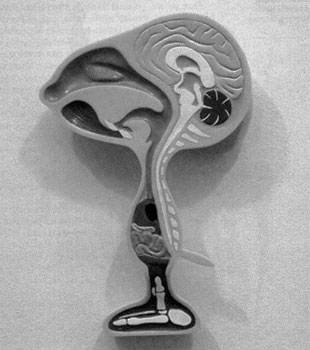David Musgrave
Duncan Cargill, London
Art Monthly, Issue 222, Dec-Jan 1998-99

Image: David Musgrave, Animal
Snoopy, obviously. It takes us a few seconds - we mentally run through pictures of possible cartoon characters, trying to find a match - but it simply has to be Snoopy. The full-profile outline, coupled with the surface coloration, provide sufficient evidence for a positive identification.
This is Animal, a 21cm tall lump of cast polyurethane resin. Its form is that of Snoopy, or at least how he might look if Mr Hirst had his way: Snoopy has been bisected. So we are faced with the misshapen organs of a cartoon dog. A cursory examination allows us to conclude that cartoon creatures have highly developed mental capacities (and consequently a great potential for subconscious desires) since their outsized heads house equally outsized brains. Presumably this is in order to process the abundant information that streams in from their outsized eyes, nose, mouth and ears. Unfortunately for Snoopy though, he is top-heavy to an extraordinary degree; suffering from limited capacity in the bowel department. His torso's girth measures little more than his neck's. A biologist would conclude that, not only would Snoopy struggle to remain upright, but his digestive system would be unable to produce sufficient energy for his brain to survive. Poor Snoopy.
But we shouldn't worry. Snoopy was never meant to be anatomically correct; he's a cartoon. Musgrave knows this, of course, he's employing a bit of double irony in deliberately misunderstanding the joke. Schultz knew that this dog couldn't survive, and Musgrave knows that he knew it too. But this rationalisation is all part of Musgrave's larger project of attempting to reconcile image and object, vision and material. For example, what makes us say that Snoopy is a dog, when every other dog we've ever seen has been anatomically correct, and so different from Snoopy? At some point we must rationalise these images of dogs into a concept of dog. This concept must be sufficiently malleable to include such mutants as Snoopy. This is the terrain - between the perfect dumbness of material and the conscious recognition of an image - that Musgrave stakes out.
This explains his Doodles. Crudely modelled in plasticine, Musgrave has produced a vaguely human form, like some undead Morph. This has then been photocopied to generate the kind of seductively dark images that photocopiers can't help but produce. Finally, these images have been meticulously copied in black ballpoint pen. Thousands of delicate horizontal lines make up the lovingly rendered images, so they have moved from modelled, then mechanical, and now into graphic states. Flecks of white generated by the photocopier become the stars of deep space in a schoolboy's sci-fi masterpiece. Equally, the sloppy handiwork evident in the plasticine becomes laden with potential energy through the obsessional labour, so lending a gravitas - whether warranted or not - like a monastic labour measured in devotional sweat. Obsession is easily quantified.
So a human effigy has been mechanically reproduced, then this reproduction has itself been reproduced manually. Again we are left with a tension between image and material. If objects can be invested with meaning (and this is a romantic notion, but one much subscribed to nonetheless) then these drawings carry an investment of meaning beyond any depiction. Like religious icons - which, incidentally, they resemble - they rely on an extreme of devotional detail to convince. But this hyperreality of detail has flattened the image away from its material origins, making us forget that the intricacies of tone are actually nothing but the slapdash squidging of plasticine or the random degradation of a copier. The image has been removed from its material origins: the crude model becomes an existential figure in space, purely through meticulous production and our ability to conceptualise images into types: 'this is a figure in space'. The paucity of the model would make us laugh, but the drawings tend towards profundity.
The show's tour de force is Giant, a large wall painting that stretches out across the largest wall in the gallery. Beige lines delineate a shape that, at first, is difficult to read. The upper left portion is a disk seen at an angle, dragging a slew of trailing lines behind it. Maybe it's the Starship Enterprise travelling at warp factor nine. But the jagged edges, and the way the lines darken as they overlap suggest a more prosaic reading. Our brains tell us that this image has been transformed: stretched a little vertically and a lot horizontally. This impression is compounded by the structure of the gallery, which is not square. This long wall meets the glass frontage at an obtuse angle, giving the entire space a skewed feel. So, if our intuition is correct, this is some sort of Holbein-esque anamorphic projection, and all we have to do is find which angle we should be viewing the image from.
Squat down low, close to the wall. Let your gaze rake the wall. We haven't quite found the convergence point (it's below ground), but we're close enough. The image is plainly a matchstick man drawn with strips of torn masking tape. Yet this giant, when seen straight on, still retains an aspect of the Starship Enterprise, as well as that of an angel (a jagged arm is stretched into a wing), and of course that of the matchstick man. This is where Musgrave's work functions most powerfully: when the material is impoverished, yet through the simplest of transformations the image still manages to convince. Perhaps we can conclude that Musgrave's mission is - in the most positive way - to badly go where no man has gone before.
— End —